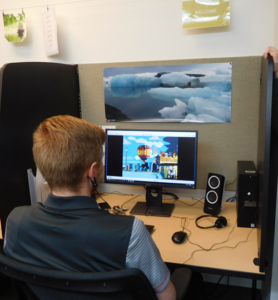Depression on campus is an ongoing issue that colleges must face. According to the American College Health Association, the number of students who report ever being diagnosed with depression has more than doubled since 2000, from 10 percent to 22 percent in the spring of 2017.
But Dr. Paul Granello, an associate professor of counselor education at Ohio State University (OSU), is trying to turn those numbers around with his creation, the Stress Management and Resiliency Training (SMART) Lab. “We keep losing people to suicide on college campuses around this country,” he says. “The stress of the college student has gone up significantly.”
An idea is born
A few years ago, Granello, whose wife is an OSU professor who counsels students in the college’s suicide prevention program, was looking for additional ways to prevent suicide. Treatment programs for anxiety and depression had been sufficient, he says, but preventative programs—before students get to crisis mode—were lacking. So Granello developed a SMART lab that pairs wellness coaching with biofeedback. The biofeedback, provided by HeartMath, offers scientifically based tools and technologies to empower students to self-regulate their emotions and behaviors to reduce stress and unlock intuition.
The lab, which cost $10,000 to create, has served more than 700 students since it opened in 2017. It is housed in the Physical Activity and Education Service building and is open 21 hours per week. When students visit, they use computers and Heart Math’s emWave Pro devices, which have sensors that measure heart-rate variability or gaps between heartbeats.
Nine students, including four doctoral students, operate the lab, which is a collaboration of the Department of Educational Studies and OSU Student Life. “The lab trains people in stress management and resiliency skills,” says Granello. “It’s a nice way to show students they are making progress.”
How it works
For about 45 minutes, students sit at a computer with an emWave Pro sensor and receive guided coaching, via videos and games, to breathe so their heart rate is rhythmic. In one exercise, students might see a black-and-white picture of a garden. Eventually, the garden bursts with color and little animals appear. “The longer the student remains in relaxation, the more the picture develops,” says Granello.
Granello’s staff helps students learn to breathe deeper or slower, and students can chart their success. Different colored zones flash on the computer, with green meaning most relaxed and red being highly stressed. It shows the time they are in each zone so they can compare their current session with previous sessions. Granello says that 86 percent of people claim it’s helpful. “It’s not rocket science, but like all behavioral solutions it’s all about practice. We have found significant results in three to four sessions with students.”
Granello is confident of the lab’s merit. “Certainly, universities like Harvard have had stress labs for a long time but I don’t know if they are doing it on such a large scale. And it’s not just for clinical research. It’s really a skilled lab for students for better coping.”
Mindfulness and breathing
This year, OSU handed out iPads to 8,000 freshmen. In time, Granello would like to have his lab’s staff meet with every student who is using Heart Math’s Inner Balance app on their iPads so they can de-stress anytime, anywhere, on their own. “Essentially, if you can breathe, you can do this,” he says.

